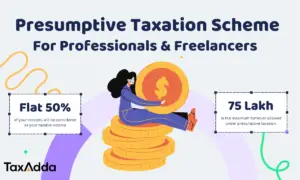If any immovable property is sold below the stamp duty value (or circle rate) then such case will fall under Section 50C, Section 43CA, Section 56(2)(x) and double taxation shall apply on the difference in the stamp duty value and transfer price.
Taxability in the hand of Seller
If the immovable property is considered as a capital asset
As per Section 50C, if a capital asset, being land or building or both, is transferred for a consideration below the stamp duty value, then such stamp duty value shall be the deemed value of the consideration for the purpose of calculating capital gain under Section 48. The original consideration paid for the transfer shall not be considered for the purpose of capital gain in the hands of the seller.
However, if the date of an agreement fixing the amount of consideration and the date of registration for the transfer of the capital asset is different then the stamp duty value as on date of agreement may be taken for the purpose of computing full value of consideration. Provided that the amount of consideration or a part thereof has been received by way of an account payee cheque or account payee draft or use of electronic clearing system through a bank account, on or before the date of the agreement for transfer.
Finance Act 2018 (applicable with effect from 01st April 2019) has amended the applicability of Section 50C only in those cases where the stamp duty value exceeds one hundred and five percent of the consideration so received or accrued for the transfer of capital asset, being land or building or both.
Also Read – TDS on Sale of Immovable Property – Section 194IA, Form 26QB
If the immovable property is considered an asset other than capital asset such as stock in trade
As per section 43CA, if an asset (other than a capital asset), being land or building or both, is sold below the stamp duty value then such stamp duty value shall be deemed value of the consideration and used for the purpose of computing profit and gains from transfer of such assets.
However, if the date of an agreement fixing the amount of consideration and the date of registration for the transfer of an asset is different then the stamp duty value as on date of agreement may be taken for the purpose of computing full value of consideration. Provided that the amount of consideration or a part thereof has been received by way of an account payee cheque or account payee draft or use of electronic clearing system through a bank account, on or before the date of the agreement for transfer.
Finance Act 2018 (applicable with effect from 01st April 2019) has amended the applicability of Section 43CA only in those cases where the stamp duty value exceeds one hundred and five percent of the consideration so received or accrued for the transfer of an asset(other than a capital asset), being land or building or both. Also, if the date of an agreement fixing the amount of consideration and the date of registration for the transfer of an asset is different then the stamp duty value as on date of agreement may be taken for the purpose of computing full value of consideration. Provided that the amount of consideration or a part thereof has been received by any mode other than cash on or before the date of the agreement for the transfer of the asset.
Reference to the valuation officer (available to the seller in both option mentioned above)
Where assessee claims before any Assessing Officer that the stamp duty value exceeds the fair market value of the property as on the date of transfer and such stamp duty value has not been disputed in any appeal or revision or no reference has been made before any other authority, court or the High Court, the Assessing Officer may refer the valuation of the asset to a Valuation Officer.
- If the value assessed by Valuation officer is lower than the stamp duty value, the assessed value shall be considered as the deemed sale price.
- If the value assessed by Valuation officer is higher than the stamp duty value, the stamp duty value remains deemed sale price.
So, if the reference is made to the Valuation officer then it may be possible that the stamp duty value may decrease but it cannot be increased on the basis of the valuation officer.
Taxability in the hand of buyer
Finance Act 2017 (applicable with effect from 01st April 2017) – As per Section 56(2)(x), any person receives an immovable property for a consideration which is less than the stamp duty value of the property by an amount exceeding fifty thousand rupees, stamp duty value of such property as exceeds such consideration shall be taxable as income in the hands of buyer and chargeable under the head Income from Other Sources.
Finance Act 2018 (applicable with effect from 01st April 2019) – As per Section 56(2)(x), any person receives an immovable property for a consideration which is less than stamp duty value of the property and such excess is more than:-
- the amount of fifty thousand rupees and
- the amount equal to five percent of the consideration
then stamp duty value of such property as exceeds such consideration shall be taxable as income in the hands of buyer and chargeable under the head Income from Other Sources.
Section 56(2)(x) shall not apply to any property received:-
- from any relative; or (Meaning of Relative)
- on the occasion of the marriage of the individual; or
- under a will or by way of inheritance; or
- in contemplation of death of the payer or donor, as the case may be; or
- from any local authority as defined in the Explanation to clause (20) of section 10; or
- from any fund or foundation or university or other educational institution or hospital or other medical institution or any trust or institution referred to in clause (23C) of section 10; or
- from or by any trust or institution registered under section 12A or section 12AA; or
- by any fund or trust or institution or any university or other educational institution or any hospital or other medical institution referred to in sub-clause (iv) or sub-clause (v) or sub-clause (vi) or sub-clause (via) of clause (23C) of section 10; or
- by way of transaction not regarded as transfer under clause (i) or clause (iv) or clause (v) or] clause (vi) or clause (via) or clause (viaa) or clause (vib) or clause (vic) or clause (vica) or clause (vicb) or clause (vid) or clause (vii) of section 47; or
- from an individual by a trust created or established solely for the benefit of a relative of the individual.
Where the date of an agreement fixing the value of the consideration for the transfer of the asset and the date of registration of the transfer of the asset are not same, the stamp duty value may be taken as on the date of the agreement for transfer and not as on the date of registration for such transfer. However, this exception shall apply only in those cases where amount of consideration or a part thereof for the transfer has been paid by way of an account payee cheque or an account payee bank draft or by use of electronic clearing system through a bank account, on or before the date of the agreement for transfer of such immovable property:
Note:- Similar option of referencing to valuation officer (as available under Section 50CA) is also available to the assessee.
A Subsequent Sale of Such Property
If the property is considered as Capital Asset
As per Section 49(4), the cost of acquisition for the purpose of calculating capital gains on subsequent sale in the hands of the buyer (i.e. seller in the subsequent sales) shall be the stamp duty value of the capital assets.
If the property is considered other than capital asset such as Stock
There is no special section which allows the assessee to take the benefit of the enhanced cost on which tax has been paid under section 56(2)(x) at the time of purchasing of property. If assessee treats such immovable property as stock in trade then the original transfer price (not stamp duty value) shall be used for the purpose of calculating profit and gains from a business on the subsequent sale.

